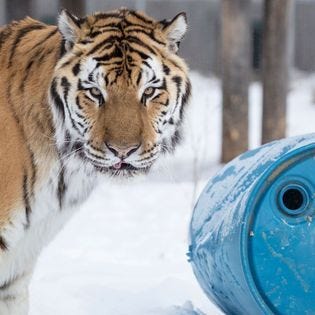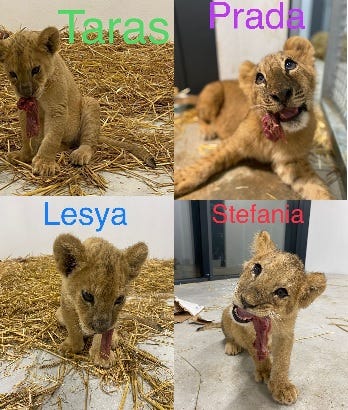“Are you stalking us? You're so silly. Everything is so much fun,” says Tammy Thies, Executive Director of The Wildcat Sanctuary in Sandstone, Minnesota.
“I like how you declare that they're stalking us but then you tell them how silly they are,” says WCCO’s Laura Oakes in response to lions, tigers and other wildcats following them from just behind a chain link fence.
It’s just happens to be another day at the office at The Wildcat sanctuary in Sandstone, where founder Tammy Thies makes the rounds checking on 130 cats of all spots and sizes.
The majority of them originated from backyard breeders and were either abandoned or surrendered to the sanctuary by their owners.
Thies is also preparing to receive four lion Cubs from war torn Ukraine, at a time when money is scarce.
“We never want people to overextend themselves and give, we want them to take care of themselves first,” explains Thies. “But if they have capacity, we really need the funds right now. It's the first time in the history really, we're seeing kind of a downturn in donations due to the economy.”
Thies gave up her job at a Twin Cities ad agency when she saw firsthand how wild animals used in television commercials were treated and she wouldn't choose any other life.
“Even though we feel they're happy here, it's really, its bittersweet still having to do the work we do,” Thies says.
The sanctuary also focuses on education according to Thies.
“We have intern programs here, because we want to educate future animal advocates,” says Thies. “And we also, during like Facebook live posts and social media, when we have this vet hospital here, we can show the damage that’s done by owning animals in captivity.”
Thies says many of the animals that are owned in captivity come to them declawed, with very poor diets, with metabolic bone disease and bad teeth.
“Once you get a cute, cuddly cub, they don’t know what to feed it, they don’t know what they’re going to do for 20 years, they can’t find a vet to work on them,” Thies says. “When they come from private owners some of them can be in rough shape even though people had good intentions. And others from the abuse and neglect cases we get through authorities can really see a hardship and need a lot of medical care.”
The Wildcat Sanctuary has a full-time veterinary team that intakes all of their animals, they spay and neuter the animals because they don’t want other cats born in captivity, and do as much preventative care as possible to keep those animals healthy.
Exotic animal trade in the United States has become big business. While there are laws against breeding and owning certain animals as pets, each state has different laws. In Minnesota, a law was passed in 2005.
Minnesota statute 346.155 prohibits people from owning a regulated animal, which includes but isn’t limited to: lions, tigers, cougars, leopards, cheetahs, ocelots, and servals. That also includes bears and all nonhuman primates, including lemurs, monkeys, chimpanzees, gorillas, orangutans, marmosets, lorises, and tamarins.
Despite those laws in Minnesota and some other states, Thies says they would like to see new national regulations put in place.
“We’re really trying to support a federal bill called the Big Cat Public Safety Act that would put an end to these backyard breeders,” Thies says. “We really need to put an end to this.”
That law has been passed by the House and now awaits Senate passage which would make it law.
Thies also points out the Netflix show “Tiger King”, despite its human flaws, brought attention to big cat breeding and captivity in a good way.
In 2021, The Wildlife Sanctuary accepted several big cats including tigers, lions and hybrid big cats seized by the U.S. Department of Justice from Jeff and Lauren Lowe, the owners of Tiger King Park, made famous by the 2020 Netflix documentary Tiger King.
“It’s finally brought an awareness that breeding and exhibiting big cats, primates and exotic animals is a big business and needs to stop,” Thies tells WCCO’s Laura Oakes.

The new lion cubs coming to the sanctuary from Ukraine have survived a harrowing first few months of life, which has included recent drone attacks and sporadic bombings in Kyiv. The cubs were transported to a zoo in Poland, and now await transfers. In the coming months, they expect to get the cubs to Minnesota where they will call The Wildcat Sanctuary home.

The Wildcat Sanctuary is participating in this year’s “Give to the Max” and accepting donations here. Contributions to The Wildcat Sanctuary goes straight to work helping save lives of wild cats in need.
The Wildcat Sanctuary is not a zoo and is not open to the public. They do offer a virtual tour and also accept volunteers to help. You can find more information here.


